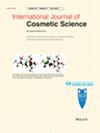In vitro, ex vivo, instrumental and clinical evaluation of a topical cream on the signs of periorbital ageing
Abstract
Objective
Periorbital skin ageing signs are multidimensional, highly visible and a concern for many. We evaluated the potential efficacy of an eye cream to diminish these signs.
Methods
Biological markers associated with ageing, barrier function and homeostasis were analysed in vitro to determine the effects of topically applied eye cream, compared to those of a placebo using human skin tissue models and/or explants. Collagen IV, elastin and bone morphogenic protein 4 (BMP4) expression was investigated by immunohistochemical labelling, while filaggrin, kallikrein 7 (KLK7) and HB-EGF were evaluated by RT-qPCR. IL-1α and melanin levels in darkly pigmented skin models were also quantified. The protective effect of the cream on glycation was assessed by a non-enzymatic assay. Finally, the benefits of twice-daily applications of the eye cream for 56 days were instrumentally and clinically evaluated on 33 women.
Results
Only the eye cream, not the placebo, stimulated collagen IV and BMP4 protein expression, as well as increased elastin fibre length. It also led to higher HB-EGF, filaggrin and KLK7 mRNA levels. The placebo and the eye cream did not induce changes in IL-1α and melanin levels, but both reduced non-enzymatic glycation. When assessing the in vivo effects of the cream, short-term results indicated skin hydration, transepidermal water loss (TEWL) and skin profilometry improvement within 15 min. Instrumental evaluations of wrinkles showed a reduction after 7 days, which was clinically perceivable after 28 or 56 days. The eye-opening angle and eyelid sagging also improved after seven and 28 days, respectively. Finally, dark circles became lighter within 7 days (instrumental measurement) or 28 days (clinical assessment).
Conclusion
The instrumental and clinical evaluations revealed that the eye cream reduced all periorbital ageing signs evaluated. Its effects are supported by the in vitro and ex vivo analyses of molecular markers.


 求助内容:
求助内容: 应助结果提醒方式:
应助结果提醒方式:


